How An Afternoon in the Woods Eased My Battle With Anxiety
For years, my mental health suffocated me. But my first forest-bathing adventure taught me how to breathe.
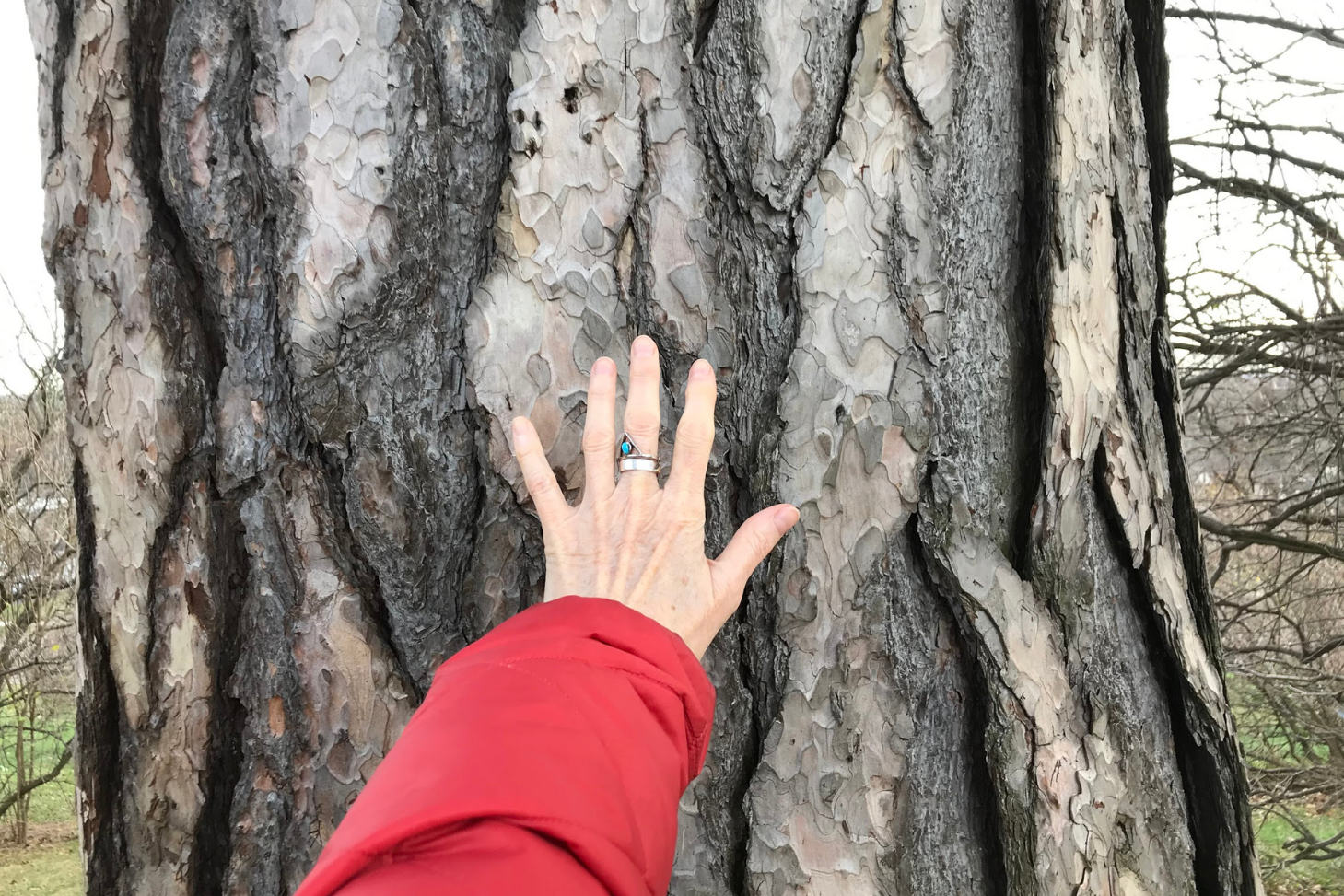

Our guides, two certified members of the Association of Nature of Forest Therapy, motioned for us to “find a tree to resonate with.” We stood in the middle of a wooded area full of Eastern White Pines and Silver Maples struggling to surrender the harsh winter. Trees of all shapes and sizes populated the surroundings. So a lot of candidates for “resonation” existed. But I had no idea what to look for. And this instruction perplexed me. I knew the term “tree hugger,” but it wasn’t something I was about to do, especially not in public surrounded by the forces of nature, my friend, and my two guides. Then it began to sink in that our guides weren’t talking about a physical embrace with the sturdy oak beside me. She meant a psychological release, explaining the tree was a living being, just like any human, and its eyes and ears were open for me to express myself here, in the forest, a place far different from the outside world where that isn’t often possible. I looked at the tall, leafless tower of bark who was about to become my therapist and wondered if it (or he? she? they?) was prepared. I had a lot to share.
There have been few days in the past five years in which I haven’t felt completely debilitated by overwhelming anxiety. From constant panic attacks to trouble sleeping, my inner demons have haunted me for some time. This began as simple anxieties that are common for teenagers finding themselves, ranging from stress over test grades to wondering if I had said something to upset my friends. But as I entered high school, those simple anxieties evolved into much worse, culminating in the horror that served as my junior year.
In February 2017, when the stresses of that year reached their peak, my dad suffered a stroke. At that moment, all anxieties reached cataclysmic levels, and they haven’t lowered since. It was after that moment that the pieces of the puzzle began to disappear. My friends started to realize that I was too much of a burden to carry. School staff began to place a watchful eye on me. I told my mom I was truly holding on, knowing that my father was doing the same. But even when my father checked out of the hospital, knowing that he’d never be his former self again, I couldn’t be the same either.
We’re always told that “it’ll get better.” In reality, it won’t. Not unless we try to make it so.
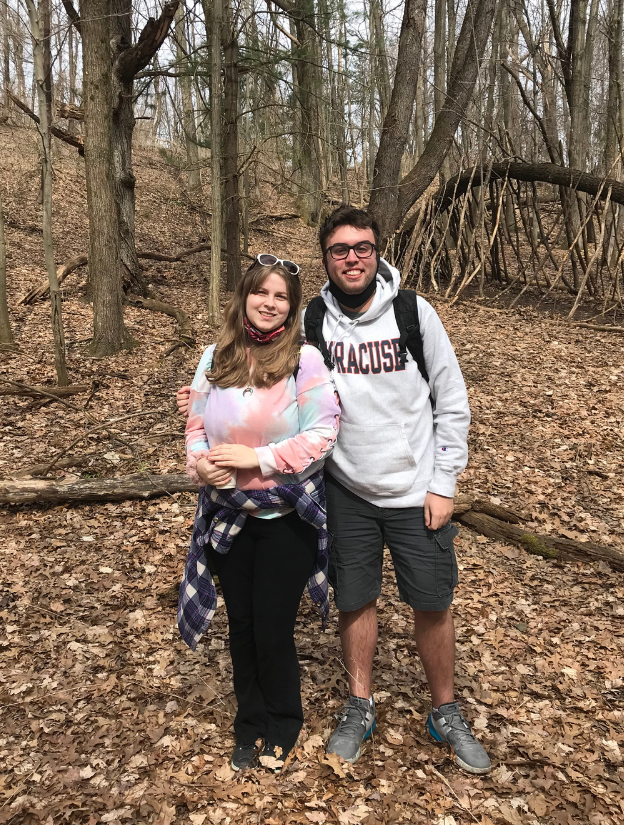
Ethan Garcia and Lauren Wiener reminisce on their first forest bathing experience, taking a second to capture a moment that they will forever remember. Photo by Barbara Monsour.
No therapists or specialists, nor prescriptions and dosage changes have returned me to my once extroverted, joyful state. I’ve resigned myself to a “grit my teeth and bear it” approach to life, but over time, maintaining the walls I built to protect myself has become more and more difficult to sustain. But the pandemic delivered some relief. Within this past year, conversations about mental health became part of our daily lives, helping to reduce the negative stigma once associated with these challenges. According to studies done by the Kaiser Family Foundation in early 2021, 41.1% of adults in the United States communicated some sort of challenge with mental health during the past year of the pandemic, and I’m certainly a part of that. But despite the crowds joining me on the anxiety boat, I still longed for an escape. And as the pandemic progressed and people sought refuge beyond the shelter-in-place confines of beds and couches, I learned about something that just might reduce my pain — forest bathing — which explains my psychological embrace of that sturdy oak.
Shinrin-yoku, translated loosely as forest bathing or forest therapy, began as a practice in Japan in the 1980s and as a source of relief for the country's salaryman culture, which features 80-hour work weeks, limited sleep, and binge drinking. To combat that, forest bathing involves complete sensory immersion in any natural area and requires those partaking in said immersion to remove themselves from their normal lives and allow their vulnerabilities to unfurl. What began as an antidote to toxic work culture has grown into a medicinal practice (even Canada offered forest bathing as pandemic-related stress relief for healthcare workers). Today, Japan designates areas specifically for forest therapy. Many locations require a doctor’s prescription in order to enter, and doctors often take the vital signs of participants before and after their immersion, noting changes in their blood cell count, stress levels, and heart rate.
For years I’d tried to convince myself to just grit and bear the pain, never truly realizing how much it had stained my soul until this moment where the world drifted away briefly.
The practice also spawned notable research by Takayama et al. in urban and forest areas in Japan with positive and restorative feelings being felt more by subjects that immersed themselves in forest environments rather than urban environments. Around the world, other researchers have begun to investigate the initial Japanese studies and relate them to their own homelands. Kirsten McEwan, senior research fellow at the University of Derby in England, conducted the first forest bathing pilot study in the UK late last year, taking a group of people on their first forest bathing experience to learn more about how immersion in nature affects a person’s physical and physiological health.
“We followed people up three months later to see if the effects would last beyond the session, and the findings were really strong; we found that 88% of our participants showed an average 29% reduction in self reported anxiety, which is great,” McEwan says. “And the effect sizes were similar to what the Japanese were finding... so it's enough of an increase that it would make a significant impact on a person's day-to-day quality of life and health.”
Amos Clifford brought the practice to the United States in 2012, incorporating his experiences with adventuring through nature, meditation, and teaching. He founded the Association of Nature and Forest Therapy (ANFT) to educate others about the practice and train them to become certified guides. According to their website, there are more than 850 trained guides in 55 countries across six continents since they began the training process in 2014. There has been an exponential increase in the number of guides in the past few years, which they attribute not only to the growing realization of the importance of nature, but also the increased interest in ecotherapy. And within this past year, guides all over the country have seen more interest from the public in their practices having been isolated in their homes throughout quarantine.
“I mean, we were busy last summer with guiding through COVID, but we really didn't know whether that increase would show up in the winter,” says Helene Gibbens, a certified forest therapy guide who does her practice with Adirondack Riverwalking located in the Adirondack Mountains in upstate New York. “We’re surprised. We’re delighted.” Gibbens says the uptick suggests a few things. “It tells us that because people are feeling isolated and are social distancing and so many of them working from home, people are feeling the need to get outdoors more strongly,” she says.
I learned from speaking with Nancy Kopans, a certified forest therapy guide that practices in the New York City area with Urban Edge Forest Therapy, that the “ideal” location to practice forest bathing is in a wooded area, but it is not required. Rather, any location that gives a person access to any aspect of nature, regardless of size, can offer the same or better experience. It just requires full-body participation. I hadn’t put much thought into this previously, but for someone like myself that grew up in areas far from nature, the smallest exposure could make all the difference.
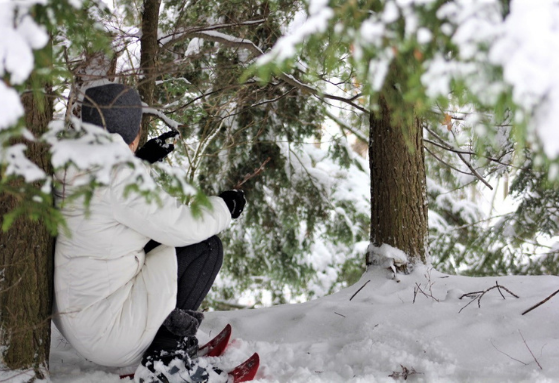
A woman resonates with her snowy surroundings during a winter forest bathing excursion in the Adirondack Mountains. Photo by Lily Yangchen, courtesy of Helene Gibbens.
“This is a different approach,” Kopans says. “We're not using our brain in the same way we're igniting our senses. We're not there to study. And we're not there to push ourselves. The whole idea is to move really slowly. And moving slowly is a real challenge for many people, in particular in New York City.” She emphasized the importance of being in your own mind in this experience, taking the moment to physically and mentally separate yourself from the hustle and bustle of the real world. Only then will you truly be able to immerse yourself in forest bathing.
After learning about forest bathing and researching personal accounts of those who, like myself, suffer from mental health issues and used forest bathing as a possible cure, I took the step to find where I could participate in this practice in the central New York area. I attended my first forest bathing experience with my friend, Lauren Wiener, a graduate student in the communication and rhetorical studies program at Syracuse University. We traveled an hour and a half through scenic western New York to Mendon Ponds Park near Rochester to partake in a session.
The park itself was one of the most expansive that I have ever seen. At the left entrance, which we stumbled upon due to driving the wrong way, lay a bird and animal sanctuary called “Wild Wings,'' where Lauren and I entered a small exhibit featuring fossils of different types of birds. Looking for the trail where we would meet our facilitators, we drove past trails with names like “Devil’s Bathtub,” of which made us question what exactly we were about to get ourselves into. Once we made our way to the right route through the 2,500 acre park, we were greeted by a large open area defined by a crystalline blue pond that seemed to act as the heart of the park. To the right of the lake was our destination: a gated-off trail that would bring whoever enters deep into the woods.
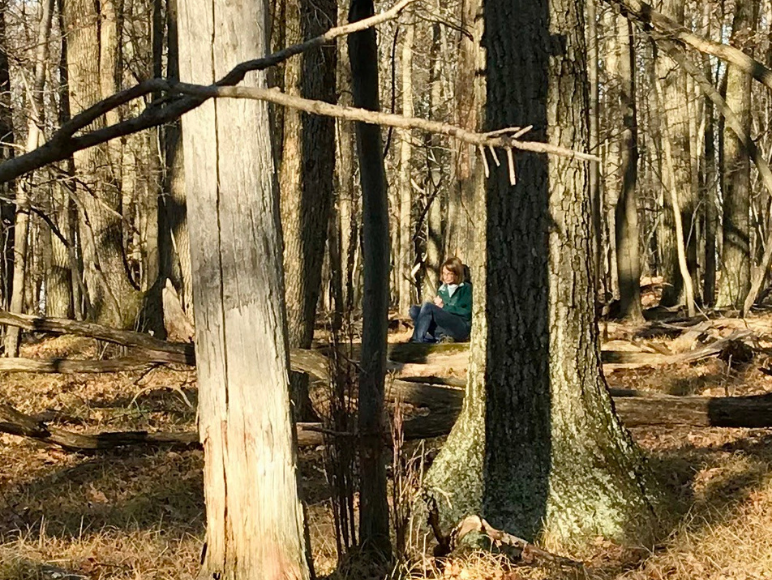
Natural formations of trees within forests are often areas of interest for those partaking in forest bathing, especially for those that may not have a developed relationship with nature. Photo courtesy of Barbara Monsour and Deborah Denome.
When we arrived, we were greeted by two women who wore their experience and love of the outdoors literally on their backs, wearing jackets, hiking boots, and hiking backpacks. These were our facilitators, two certified forest therapy guides from Finger Lakes Forest Immersion in the Finger Lakes region: Deborah Denome, a long-standing guide, feminist, educator, and herbalist, and Barbara Monsour, a newly-certified guide and friend of Denome, who she views as a mentor.
The idea of having two trained guides to lead me through a public nature trail seemed rather odd at first glance, but Kopans explained it perfectly — it’s an opportunity for us to not focus on what we’re doing and where we’re going, rather to live in the moment without that critical thought.
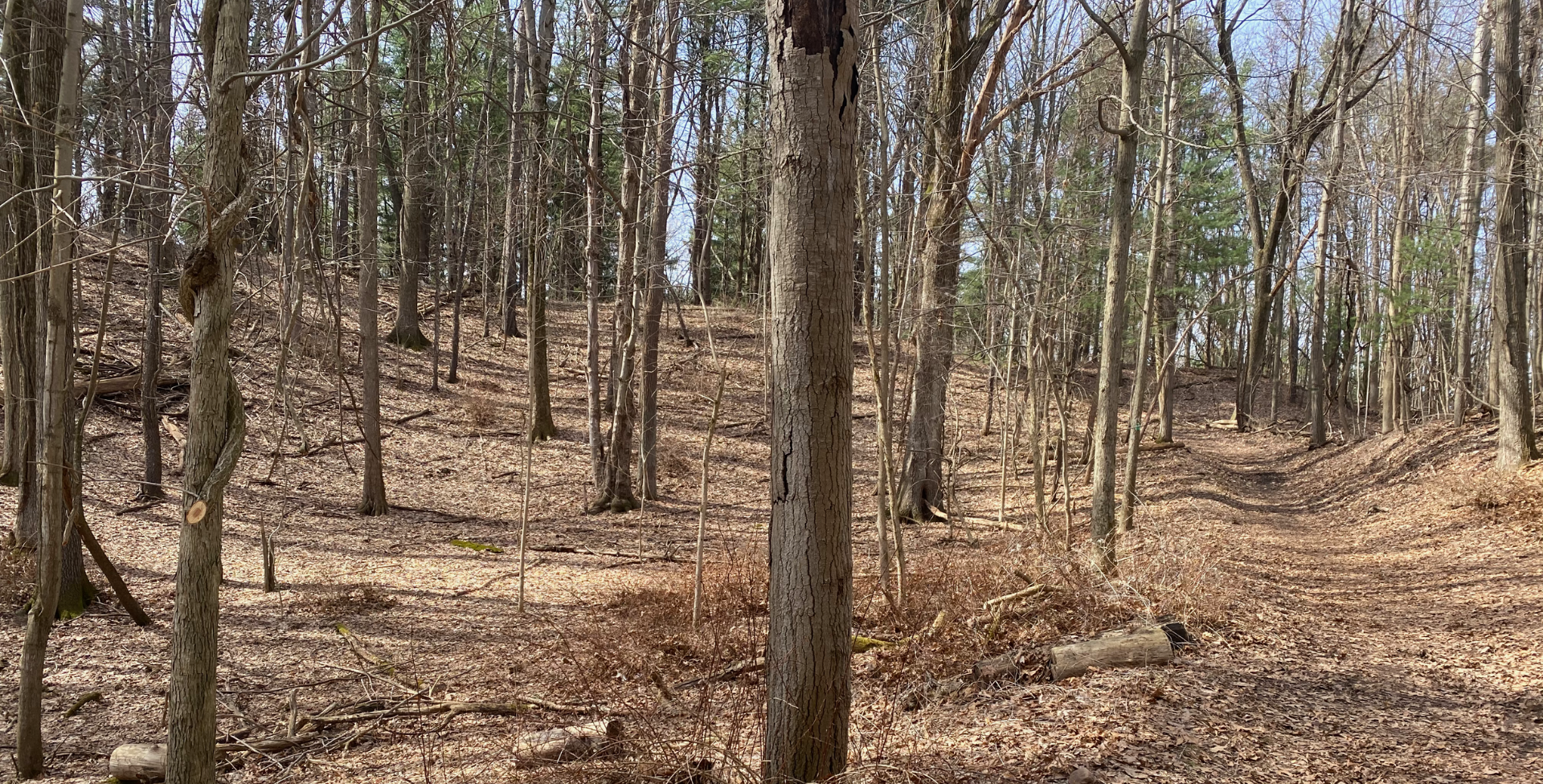
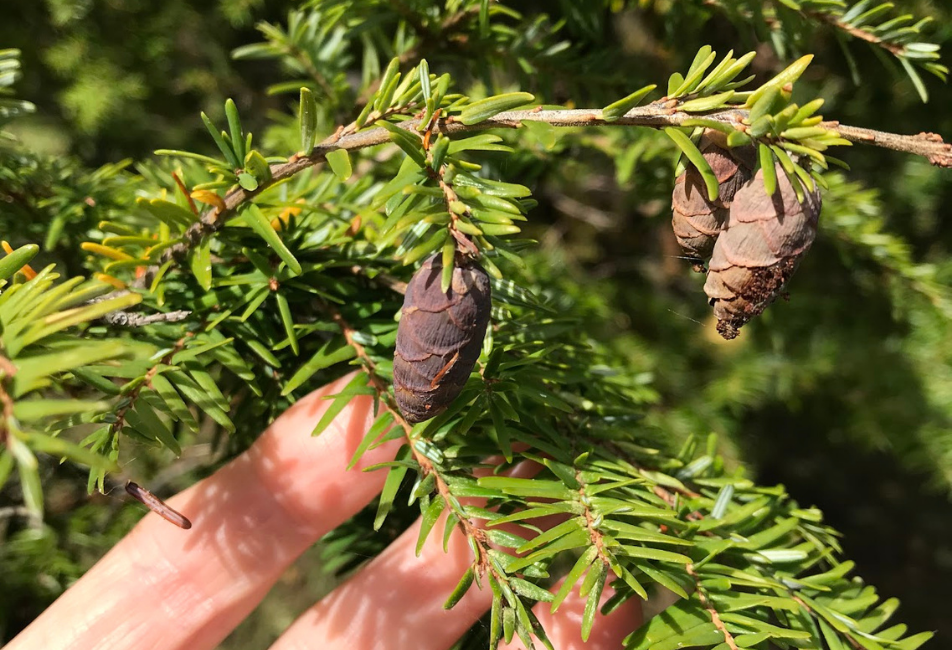
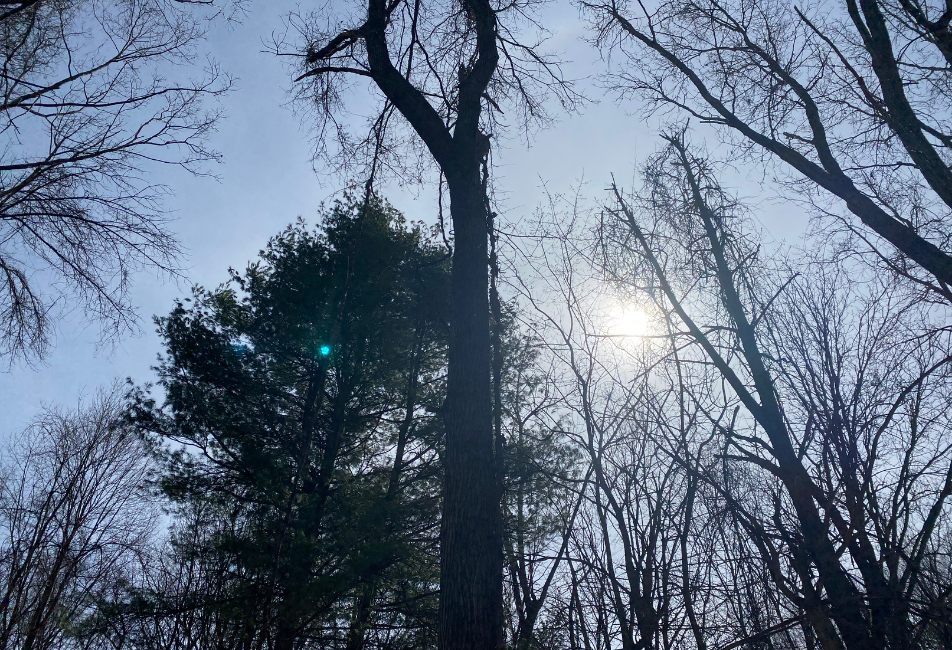
During forest bathing, participants are encouraged to resonate with any aspect of nature that stands out to them, then take the opportunity to relate themselves to it. Pine photo courtesy of Barbara Monsour and Deborah Denome. Others by Ethan Garcia.
“You know, there are contexts in life where having somebody facilitating, it's really helpful,” Kopans says. “And then you just kind of go along, you don't have to be using that prefrontal cortex, that executive functioning of ‘Okay, what am I supposed to be doing now?’ So the mere fact of having a guided experience, like a guided meditation, where you do not have to be in the driver's seat, which is, itself, putting you in a place that creates a certain sort of mindset.”
Both Deb and Barb looked like they were prepared to venture through the wilderness for weeks on end. I, however, opted for a more casual, “short exploration” vibe complete with cargo shorts and a t-shirt, signaling the fact that I have never stepped foot in the woods and possess no awareness of the abundance of ticks in wooded areas. Upon seeing me for the first time that day, Lauren, an “abandoned explorer” who spends a lot of time with her sister investigating buildings and structures vacated by humans, questioned my clothing decisions while pointing to her various sweatshirts, backpack, and safety items.
My skepticism regarding what I was about to do surpassed any excitement I had. Being from a large, bustling town on Long Island, I possess limited exposure to nature beyond the occasional wooded areas passing outside my window as I drive. Parks are scarce, making the ones that exist busy and overcrowded. Some serve as sports venues, and others feature children’s play equipment, but few provide room for open, wild nature. We’re often told to avoid open areas and forests such as this, due to the possibility of danger lurking within. Lauren and I looked at each other and questioned whether or not this was the best idea, not knowing what fate had in store for us as we walked into the empty woods with these women we had just met.
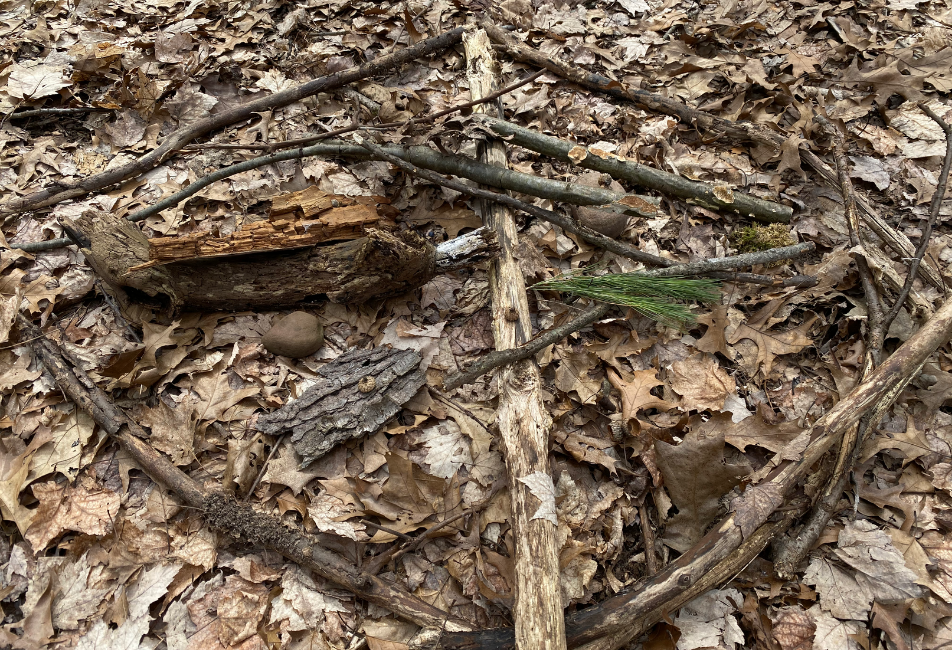
The nature offering formed at the end of our forest bathing journey lay in an opening in the woods where it could be appreciated by nature and passersby. Photo by Ethan Garcia.
As our forest-bathing journey began, I tried to shake my doubts. But the beginning activities (known as invitations) failed to bolster my confidence. We started with a small sharing circle, placing the foldable stools supplied to us by Deb off the nature trail in a clearing in the woods. This served as our introductory invitation, a time devoted to introducing ourselves to each other and sharing what we noticed in the short time it took to get to this clearing.
What I noticed was not a tree or a leaf or stone or critter but the absence of something — noise. The absolute quiet struck me. It felt as if I’d landed in the center of a horror movie, waiting for a rustle or twig snap to signal a monster, murderer, or predator lurking near. But not even the leaves we walked on offered a crackle. For once in my life, I could clearly hear my thoughts. These internal intrusions had me questioning more than just my place in these woods, rather my place in the world and how this nature surrounding me had eluded me all this time.
I’m not the adventurous type. Throughout my years in college, while all of my friends would be out exploring the city, taking in all it had to offer, I’d trap myself in my room where I found comfort. To me, the city of Syracuse continues to be a foreign place despite having lived here for four years. At this moment, surrounded by nothing but trees and foliage, I began to question why I had avoided exploration such as this for years, even before college. Although I couldn’t pinpoint an answer, this was one of the first moments that this question sat at the forefront of my mind.
In this circle, the only external sound I could hear was Barb’s voice, directing us through the first part of our sensory immersion. With my eyes closed, I noticed the feel of the foliage at my feet, the taste of the fresh air, and the smell of the decay brought about by the winter. When I opened my eyes, the woods around me had taken a new form. I felt that I was in the embrace of a friend, someone that was looking out for me and allowing me to express my vulnerabilities. But as soon as that feeling arose, it quickly faded, yet I told myself to progress through this journey as it had only just begun.
Our next invitation centered around movement, not only our own but that of our surroundings. Barb instructed us to spend 15 minutes gazing along a small part of the nature trail and bringing ourselves to whatever aspect of the woods our bodies compelled us to investigate. Whether that object was moving or stationary, our guides encouraged us to note how it got there and what moves within it, under it, and over it.
I found solace in a small patch of snow centered at the bottom of a steep hill and surrounded by the reds and browns of decaying foliage — the only sign of winter that remained. As a student at Syracuse University for more than three years, I know snow. That certainly isn’t scarce here. Perhaps that explains its pull. I saw that Lauren had become entranced by a vine barely holding on from one of the tallest trees in the vicinity. She took the vine in her hand and began to lightly swing it around. I began to feel empathy for that vine — the phrase “holding on by a string” is one that I’ve long used to describe the stressful circumstances I’d found myself in, but that was exactly what the vine was doing. Would I be able to use an expression like this when in actuality it might not be the truth?
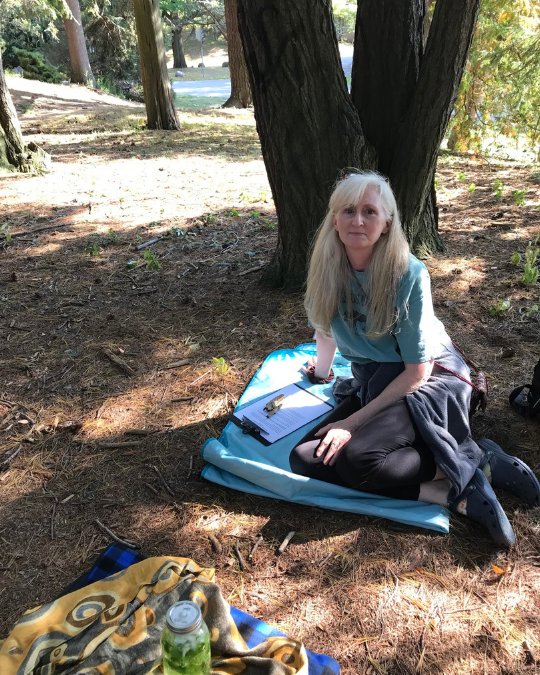
Barbara Monsour rests in front of a tree during the tea ceremony at the end of one of her forest bathing journeys, which is a customary way to end the practice and allow for final reflection. Photo courtesy of Deborah Denome.
Next came the memorable “befriending a tree” experience. I wasn’t entirely certain as to how this invitation would play out, but I did know that I wasn’t about to overshare to a tree and risk other people on the trail hearing me. I approached a rather large tree in an open clearing and decided to focus on it, working to decipher its messages and hoping to receive some kind of beneficial message, despite being very wary of the tree being able to “talk.” I placed my hand on the tree (a full-on hug seemed a bit aggressive) and tried to notice my breathing. The bark was coarse but brittle, showing clear signs of the age of the tree. I tried my best not to press too hard, not wanting to injure what had lived here for so long. It entered and exited my body in a calm, steady pace, a rhythm that felt foreign and unlike the jags and accelerated huffs of my normal oxygenation. Above me, I heard the branches of the tree waving in the wind, as if it was attempting to signal that it heard my call for help.
Then came the invitation that resonated most with me — sound. The deafening silence in the woods returned to me. In this silence, I heard the loudest noise: my own thoughts. I was bombarded by memories from my final few high school years, feeling just as potent as when they had actually occurred. Then came this feeling of overwhelming sadness, as if the burdens I’d held for so long had begun to weigh further on my shoulders, pushing me down into the earth to join the foliage decaying into the soil. But I didn’t try to fight it. I needed to accept it. This was a valid emotion for me to be experiencing regarding events I had yet to move past, despite how hard I tried to convince myself that I had done just that. I sat there, in front of a small formation of rocks, and just listened.
The noise in my head was soon replaced by that of the nature surrounding me, which seemed to awaken as soon as I had endured my pain. I redirected my attention to the cool breeze, and that reconnected me to my surroundings. In response, I took out my notebook and penned a poem, trying to capture my state of being at that moment and releasing all of my thoughts onto the paper. Confession: I may like to write, but I’ve never once written a poem for leisure. But at this moment, I felt that I would be doing myself a disservice if I didn’t take a second to format my thoughts in iambic pentameter. The thoughts in my head felt like they were signing to me (not laughing, yelling, or cursing at me), attempting to grab my attention and ground me.
After finishing the short poem, Barb made a jarring wolf call — signaling I needed to rejoin the group. I stood up, took a deep breath, and stepped back into the moment. The invitation that followed centered around our sense of touch and how we perceive the objects we feel with our bodies to live alongside others in nature. I led myself to another spot and stumbled upon a large clearing where small, smooth rocks lay outside of what appeared to be a den. Without disturbing the wildlife, I picked up a rock that piqued my interest. The small rock’s cracks and grooves made it clear that it had been through quite a lot. I could relate.
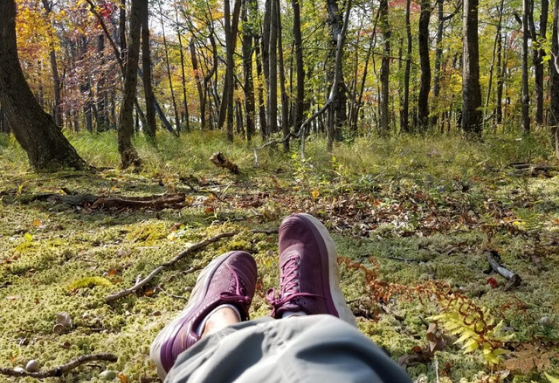
“We're not going to heal environmental crises until people are connected to nature and realize you know, how in love they are with nature and want to support nature. If we don't make that connection, we will never fully heal,” says Deborah Denome. Photo courtesy of Barbara Monsour and Deborah Denome.
Then after another wolf call, we reconvened in the clearing, which this time featured a centerpiece of twigs, bark, and a blanket with a thermos and cups next to it. This would serve as our Covid-friendly, makeshift tea ceremony, a practice traditionally done at the end of forest bathing walks with the goal of releasing final thoughts and sharing a lasting moment of tranquility. Barb gave us the opportunity to add our pieces of nature to the pile of twigs in front of us, which she described as an offering to the land — giving our thanks to all who came before, those that currently pass through this land, and all those to come.
Lauren seemed to resonate very closely with this invitation. I’ve known her to be interested in discovering items scattered across abandoned areas, but to see her channel her interest toward rocks, twigs, and clumps of grass at our feet made me feel that this meant something to her too.
She held out a small twig of pine needles that had fallen off of a tree. This was the only green thing I had seen throughout this entire adventure in these barren woods. This plant seemed to brighten her complexion. She smiled. She presented the item to us as if it held sentimental value, and then placed the twig in the center of the offering.
The pandemic forced us to exchange a kettle, tea, and teacups for nature-connected drinks in compostable cups. Deb welcomed us with maple sap, which she tapped from the silver maple trees in her yard right before they began to flower. The sweet yet subtle taste of the maple in the sap prompted me to wonder if I was ingesting scented water, or if this truly was the product of a tree’s labor. The thickness of the drink brought me to that latter thought quite quickly, though.
Hot water filled Barb’s thermos and featured eastern white pine needles that created a sort of herbal tea. She explained to us that part of the training that one receives to become a certified forest therapy guide is to understand what plants in the vicinity are safe and which aren’t. Eastern white pines in particular have a very close tie to the northeastern United States, specifically the Haudenosaunee peoples and other tribes that resided in the northeastern portion of the country. According to researchers at Bellarmine University, many indigenous peoples utilized the bark of the tree for medicinal purposes due to the potency of its sap. Compared to the maple sap, the warmth and slight bitterness of the drink helped open my sinuses, allowing me to process the fresh air around me even better.
As our session concluded and we headed off in our separate ways in our candy-colored cars, I looked back at the trail. We had only traversed through a small portion of all of the nature available to us. Taking a seat in the car, I took a second to adjust the seat, lay back, and take a deep breath. As I took a moment to think about the two hours that had just passed, I struggled to describe it to myself. Did it work? I wondered. Am I cured? Well, no. But as we started the car and began to pull out of the parking lot, I looked back one more time and felt a strange sadness, as if I was saying goodbye to an old friend. This brief, two-hour period offered me the chance to sit down and listen to what I was telling myself, things that I needed to hear. For years I’d tried to convince myself to just grit and bear the pain, never truly realizing how much it had stained my soul until this moment where the world drifted away briefly. I never thought that being surrounded by trees and foliage, completely separated from the noise, traffic, and people of the city would provide a method to combat my terrible mental health. But it did. For those few moments. I know my anxiety will never truly be “fixed,” but for a brief time period I felt at ease.
We’re always told that “it’ll get better.” In reality, it won’t. Not unless we try to make it so. And unfortunately, for those at odds with their mental health, the willingness to try is replaced with the willingness to accept defeat. But I saw a flicker of light, and I was tired of letting those flickers fly by. So I grabbed it. Something that those walls I built all of those years ago rarely allow me to do. It may not have been a perfect fix, but for the moment I felt like myself. My true self. The one who finds solace in writing. The one struggling to move on. The one ready to change.

Our pursuit of outdoor joy is remiss without the acknowledgement of the occupation of unceded Indigenous land. We are students and journalists working, writing, and living on the land of the Haudenosaunee Confederacy, comprising the Six Nations made up of the Mohawk, Onondaga, Oneida, Cayuga, Seneca, and Tuscarora nations. However, acknowledgement is not enough. Read More.